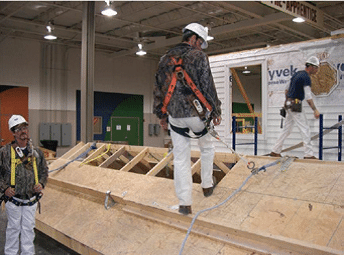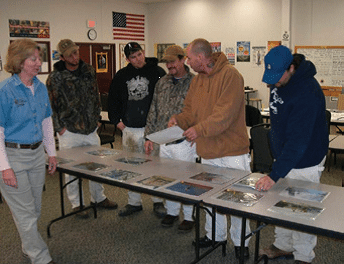Fall Prevention in Residential Construction (Completed – 2009-2014)
Bradley Evanoff, MD, MPH
Washington University, St. Louis
Ph: 314-454-8350
[email protected]
Research Team
Victoria Kaskutas, OTR/L, OTD, Washington University, St. Louis; Hester Lipscomb, PhD, Duke University; Carpenters District Council of Greater St. Louis and Vicinity; Carpenters Joint Apprenticeship Program.
This work demonstrated that training residential carpentry foremen in fall prevention and safety communication results in long-lasting improvements in fall prevention knowledge and safety behaviors among foremen and the crewmembers who they supervise. Foremen who have the knowledge, skills, and tools can become good safety leaders and drive workplace safety. This is especially important in small residential contracting companies that commonly lack the resources for safety-specific personnel. As the economy rebounds from the economic recession, it will become increasingly important to provide interventions to protect new workers who are entering the construction field. Since apprenticeship training programs are rarely offered to residential construction workers, construction worker falls will only increase as productivity demands rise. Training foremen and small residential contractors to identify fall protection methods appropriate for their building context and ensure that their workers consistently use these methods will become increasingly important. Our intervention found improvements in self-reported behaviors.
- Twelve national presentations were given.
- Four articles were published in the peer-reviewed journals Professional Safety, Work: A Journal of Prevention, Assessment and Rehabilitation, the Scandinavian Journal of Work, Environment & Health, and the Journal of Safety Research.
- Eight articles were published in trade magazines.
- Researchers created a fall prevention website that describes over 150 fall protection devices that can be used on residential construction sites, and a national fall prevention campaign Facebook page.
- Researchers started a fall prevention equipment loaning program in St. Louis, Missouri region
- Materials developed for this research were disseminated to several researchers, including the Oregon Fatality Assessment and Control Evaluation research program, Park Nicollet Institute (Dr. David Parker TECHS project), University of Illinois at Urbana-Champaign, and CPWR consortium participants.

